Photography, Outsider and Otherwise
There were some revelations and a few nagging questions in the recent show of outsider photography at Chicago's Intuit gallery, featuring Lee Godie, Eugene Von Bruenchenhein and Morton Bartlett.
A group of altered photo-booth self-portraits by Chicago artist Godie (1908-1994) was one of the revelations. Shown in quantity, Godie's photographs manage to stand apart from her better-known paintings. The 50 or so pictures have a cumulative effect that helps the viewer discern meanings not apparent in individual examples, which when seen separately can look more like funky oddities than a distinct body of work.
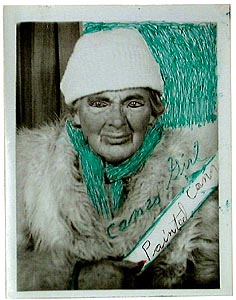
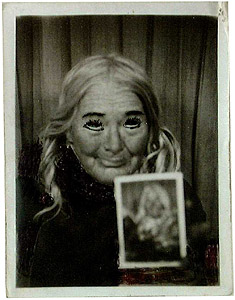 More interesting than lovely, the art in these pictures turns out to be a fairly complex mixture of modeling -- with the late Chicago bag lady costuming herself and posing for particular effects -- and modification. Godie frequently drew outlines and highlights on the photographs, adding words or heavy overwriting or over-painting.
More interesting than lovely, the art in these pictures turns out to be a fairly complex mixture of modeling -- with the late Chicago bag lady costuming herself and posing for particular effects -- and modification. Godie frequently drew outlines and highlights on the photographs, adding words or heavy overwriting or over-painting.
In portraying serial personas, Godie, who called herself a "French impressionist," apparently was rendering her own version of a post-modern pastime -- investigating identity. Curators David Syrek and Jessica Moss bring attention to Godie's intent by hanging two photographs by Cindy Sherman, today's queen of photographic identity play, adjacent to Godie's work. The pair of small, early Sherman photographs look almost like visual echoes of Godie's. That they hang so comfortably in this context reveals something about both artists, with Sherman helping to draw out Godie's self-consciousness while Godie highlights and reiterates Sherman's taste for compulsive self-portraiture.
Obviously, there are manifest gaps in technique and materials between Sherman and Godie. But is there a categorical difference between these artists, one a consummate insider and the other a textbook outsider? Curators Syrek and Moss do not seem concerned with any kind of aesthetic divide here. Rather than attempting to validate the work of a self-taught artist by showing it in conjunction with a contemporary mainstream artist, this pairing speaks straightforwardly about two artists who can be plausibly, indeed naturally, discussed in the same conversation.
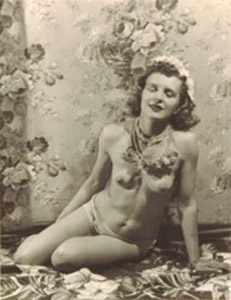
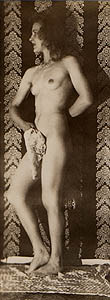
Milwaukee artist Eugene Von Bruenchenhein (1910-1983) also fits easily into this conversation. His wide-ranging art displays an expressive ambition and creativity that make him almost indistinguishable from the most talented and sophisticated of art school graduates. Self-taught in Von Bruenchenhein's case is an accident of education. An essential biographical detail sets him apart, however. Godie made and sold her work daily on the streets of Chicago; Von Bruenchenhein's body of work was created in private and mainly for private purposes. The immensity of Von Bruenchenhein's project -- which, in addition to his thousands of photographs, includes visionary paintings, geometric drawings, concrete masks and chicken-bone assemblages reminiscent of miniature Watts Towers -- and its isolation from any kind of art market have real consequences for the content and quality of his art.
Yet, Von Bruenchenhein's photographs are less of a revelation than Godie's, in part because they have been widely exhibited since his death in 1983 but also because each piece is both more accomplished and more compelling aesthetically as an individual image. If you have viewed them in other contexts, even a few, then probably you have a good sense of the work, and the power of the group in the Intuit exhibition comes as no surprise. Von Bruenchenhein's photographs, usually of his wife, Marie, are beautiful, touching and often fascinating. They betray not an ounce of the quaint or precious despite the homemade decorations and special effects that he favored.
 Compared with Godie's pictures, those of Von Bruenchenhein are more in tune with the popular cultural conventions of their time. Von Bruenchenhein may have been distanced from the art market, but he was certainly engaged with mass culture. One obvious resonance is with pinup photography of the 1950s, especially the huge aggregation of pictures featuring the now very hip model, Betty Page. Although not all the Betty Page material is as innocent as the Marie portraits appear to be, some distinct affinities in the subject matter exist. However, that parallel goes only so far. Aside from the absence of explicit sexual intent, many of the Marie pictures demonstrate a degree of photographic experimentation that is absent from their commercial counterparts, where the only thing that seems playful is Betty herself. Even when the focus is on Marie's nude body, the eroticism that animates these photos seems much deeper than in the typical pinup.
Compared with Godie's pictures, those of Von Bruenchenhein are more in tune with the popular cultural conventions of their time. Von Bruenchenhein may have been distanced from the art market, but he was certainly engaged with mass culture. One obvious resonance is with pinup photography of the 1950s, especially the huge aggregation of pictures featuring the now very hip model, Betty Page. Although not all the Betty Page material is as innocent as the Marie portraits appear to be, some distinct affinities in the subject matter exist. However, that parallel goes only so far. Aside from the absence of explicit sexual intent, many of the Marie pictures demonstrate a degree of photographic experimentation that is absent from their commercial counterparts, where the only thing that seems playful is Betty herself. Even when the focus is on Marie's nude body, the eroticism that animates these photos seems much deeper than in the typical pinup.
Ultimately, Von Bruenchenhein seems connected to a broader project that is almost spiritual in its intensity. "This is the world we make Marie," Von Bruenchenhein inscribed on one of the photographs in the Chicago show. That statement in no way overstates his achievement even as it captures the intensity of imagination and emotion with which he endowed his work.
The creations of Boston photographer Morton Bartlett (1909-1992) reflect a similarly private passion, albeit of an even more solitary kind. The intensity is embodied as much in the anatomically correct prepubescent dolls he created as in the photographs he made of them. It is surmised that the 12 half-scale, extremely lifelike girls and three boys, together with clothes he sewed by hand, were a surrogate family for Bartlett, an orphan and lifelong bachelor. The Intuit exhibition includes one of the dolls and some spare heads, in addition to the display of his photographs. One might question what impact the photographs would have had without the dolls.
Even more than Von Bruenchenhein's, Bartlett's photographs on their own seem conventional, the charming output of a talented hobbyist. They do not elicit the same feeling as the other photographs in the show but, rather, are more in tune with The Lonely Doll series of photographic children's books by Dare Wright published in the late 1950s and 1960s. Each book followed the adventures of Edith (the doll) and her two bear pals, using black-and-photographs taken in real-world settings.
Bartlett's pictures are invested with a dimension apparently lacking in Wright's books, since it is presumed that they were part of a lonely man's effort to create an alternative reality for himself. That ties them to Von Bruenchenhein's efforts to fabricate his own world, but the doll photographs are no match for Marie. Even when Von Bruenchenhein veers closest to cheesecake, his artistic depth separates his pictures from a Betty Page image in a way that Bartlett's photographs cannot be distinguished from The Lonely Doll. Wright's books may be more whimsical and less dramatically detailed, but both series are more illustration than art. Without the associated narratives, their appeal would be diminished. In Bartlett's case, this means both the imputed narrative of the remarkable dolls and his own lonely life story. (Actually, the life of model and fashion photographer Wright, were it better known, might add a similar frisson to The Lonely Doll.) This is not to say that Bartlett's photos lack artistic merit or are unappealing. But neither are they stunningly creative, either as individual images or as a body of photography.
Most pertinent to the Intuit show, it's not obvious in what sense they represent outsider photography. Perhaps Bartlett qualifies as an outsider to the extent that he does not appear to have been engaged with the fine art world. But much of the power of outsider art comes from the striving of an artist to create despite a lack of training in techniques of artistic expression. Bartlett, a former professional photographer, would have faced no such struggle making his photos. In fact, he seems to turn a certain kind of outsider art cliché on its head. Here we have eccentric personal history investing significance in technically accomplished work rather than being used to legitimate art whose execution is offputtingly primitive.
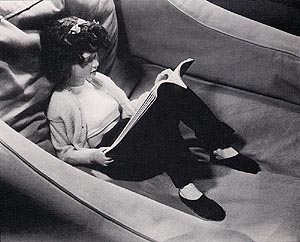
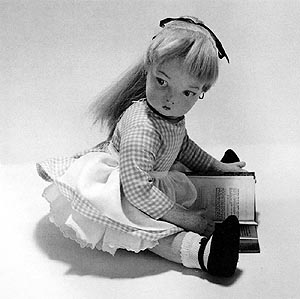 One needs to know the whole story to make Bartlett appear as any kind of an outsider -- the dolls, his eccentric bachelor life, his apparent fascination with prepubescent girls and the presumed obsession required to achieve the level of detail visible in both the dolls and the photographs. While few of Bartlett's photographs are sexually charged, the explicit nature of the dolls he made and photographed gives the work an odd, erotic aura that might not otherwise exist. The Lonely Doll parallel makes it hard not to wonder, though, how fascinating the Bartlett pictures would seem without our culture's paranoia about the sexual abuse of children.
One needs to know the whole story to make Bartlett appear as any kind of an outsider -- the dolls, his eccentric bachelor life, his apparent fascination with prepubescent girls and the presumed obsession required to achieve the level of detail visible in both the dolls and the photographs. While few of Bartlett's photographs are sexually charged, the explicit nature of the dolls he made and photographed gives the work an odd, erotic aura that might not otherwise exist. The Lonely Doll parallel makes it hard not to wonder, though, how fascinating the Bartlett pictures would seem without our culture's paranoia about the sexual abuse of children.
In another era -- for example, the one that produced the profile of Bartlett and his dolls published in Yankee magazine in 1962 -- this preoccupation might add up to just an interesting hobby. Now, after years of growing interest in various forms of self-taught and outsider art, Bartlett at last can be recognized as more than a hobbyist. But that still doesn't make him an outsider, especially when you add to his photographic experience the fact that he was "creating and manufacturing art objects for the gift trade" (his words) and was a publisher and printing designer.
Whatever the issues with Bartlett, there is a special challenge in understanding what makes any photography "outsider." What is the criterion? Is it style? Is it subject? By that measure Lee Godie has more in common with Cindy Sherman than with her own acknowledged "outsider" paintings. As some critics of the concept have asked, how can outsider style or subject matter be defined? Perhaps the photographs have to be made by someone established as an outsider artist through another medium, arguably the case with these three photographers. But how can one distinguish between outsider photography and snapshots that happen to have been taken by an outsider artist?
In the case of these artists, it could be argued that intentionality makes their pictures coherent bodies of work. But just what intention, considering that outsider art is an art that is not supposed to recognize itself as such? Photography poses an extra challenge in that millions practice it without having any specifically creative intentions. Making paintings and sculptures, by contrast, is an exceptional activity among adults, rarely undertaken without some kind of expressive purpose. When someone without previous art world experience creates a significant body of paintings, it is ipso facto something special. Even Von Bruenchenhein's thousands of photos do not, by their mere existence, set him apart from all the other Milwaukee amateurs who took roll after roll of mundane film in the '40s and '50s.
The two distinctions for this kind of photography may be the inherent aesthetic quality of the pictures and/or the obsessive character of a particular group of photographs. Both can help validate a truly artistic intent, but obsessiveness is still a questionable convention since it tends to elevate the making of the art above the art itself. Aesthetic depth is less problematic as a standard, particularly to the extent that photographs like those of these three photographers possess a thematic coherence and stylistic intensity not normally seen in casual snapshots. It still does not make for a simple categorization, though, which should not be surprising: The outsider category leads to messy discussions everywhere it is applied. The good news is that the photos in the Intuit exhibition, like all the best outsider art, can mostly stand on their own, without the crutch of the "o" word.
A version of this review originally appeared in Folk Art Messenger, published by the Folk Art Society of America.
Related links
The Latest Stuff | Roadside art | Outsider pages | The idea barn | About | Home
Copyright Interesting Ideas 2002